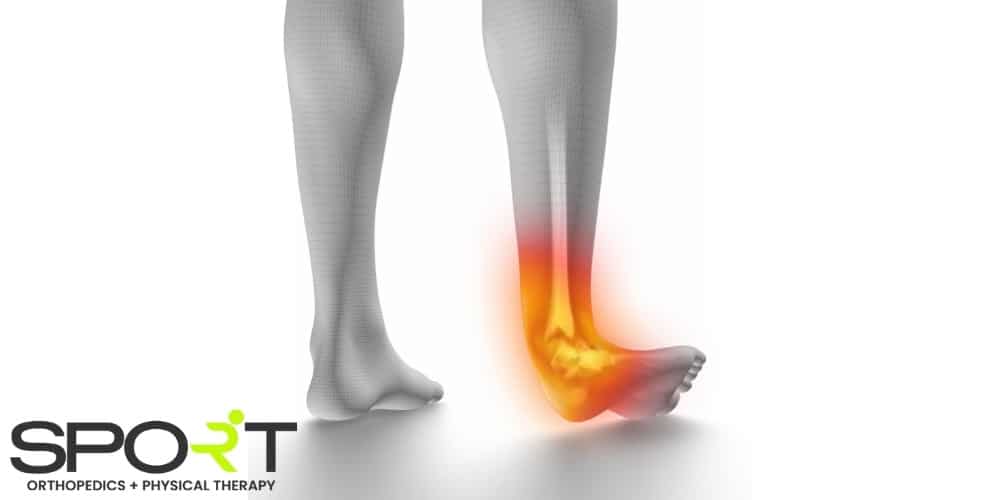Our ankles serve many important functions for our bodies. They help us walk, stand upright, balance, jog, run, jump, and so much more. Many small bones and ligaments work together to form the ankle joint. The ankle’s high level of mobility is extremely useful, but it also leaves the joint more vulnerable to ankle sprains and strains. Various types of ankle sprains exist, all caused by different movements of the foot.
The ankle is referred to as a hinge joint, and it moves in four main ways.
- Upward (dorsiflexion)
- Downward (plantar flexion)
- Inward (inversion)
- Outward (eversion)
No matter the cause of your ankle sprain, the orthopedic specialists at SPORT Orthopedics + Physical Therapy are here to offer prompt diagnosis and treatment. We have extensive experience treating various ankle sprains, as well as other common injuries to the ankles. If you are suffering from a sprained ankle, call the best Dallas orthopedic surgeons today at 469-200-2832 to schedule an appointment with us.
What Is an Ankle Sprain?
Ankle sprains happen when someone rolls, twists, or turns their ankle in a wrong or awkward way. If the ankle rolls outward too far, for example, this could stretch or tear the ligaments in the ankle. The ligaments are largely responsible for holding the ankle bones in place. Therefore, if these ligaments are damaged in any way, this results in a sprained ankle.
Several types of sprained ankle injuries exist, including the following.
- Lateral ankle sprains
- High ankle sprains
- Eversion ankle sprains
- Low ankle sprains
- Chronic ankle sprains
Regardless of what kind of ankle injury occurred, the orthopedic specialists at SPORT are here for you. We can evaluate your injury, develop a personalized treatment plan for you, and teach you how to prevent ankle sprains in the future.
Sprained vs Broken Ankle

If you suffer a severe ankle sprain, it may be difficult to tell at first whether you have injured ankle ligaments or broken bones. Severe ankle sprains and foot fractures often produce similar symptoms, as well as severe pain. We recommend seeing a doctor as soon as possible to receive an accurate diagnosis.
If you cannot get to a doctor right away, or if you’re already on your way to the doctor, look for the following symptoms to determine if your ankle is broken or sprained.
- Popping sound: Most ankle sprains do not produce sound, as they do not involve a complete tear of the ligament. If you suffer a torn ligament, you may hear a popping sound. When ankle and leg bones break, you can usually hear a crack.
- Appearance of the ankle: Swelling is normal when both breaks and ankle sprains occur. However, if your ankle looks clearly misshaped, this most likely points to a break.
- Numbness: Sprains and breaks both tend to produce pain. However, breaks can eventually lead to numbness or tingling feelings in the area.
- Location of the pain: Take note of where exactly you feel the pain. If the pain is mostly concentrated right at your ankle bone, you have probably suffered a break. If the pain is located around the softer parts of your foot, it is more likely to be a sprained ankle.
Again, we strongly recommend that you at least undergo a physical exam with a doctor. You might think you only have a mild sprain, but it could actually be a fracture.
What to Expect from a Sprained Ankle
In most cases, sprains heal within around two weeks of the injury occurring. A sprained ankle tends to be a mild injury that can improve with conservative, at-home treatment. However, a severe sprain in which there is a partial tear or a complete tear will usually require medical intervention.
If you experience any of the following symptoms, you should probably call your doctor.
- The ankle remains swollen and does not improve.
- Your range of motion is greatly affected.
- You have difficulty walking, or you cannot walk at all.
- The pain does not improve with time or with the use of over-the-counter medications for pain.
- Your ankle still feels tender and swollen after a week has passed.
- The ankle is twisted or looks misshapen in any way.
Can You Walk on a Sprained Ankle?
Technically, you can still walk with an ankle sprain. However, we strongly advise against this. If you walk with an injured ligament, you will likely delay or halt the healing process. This can also increase your risk of complications and future ankle sprains.
Many people sprain their ankles while walking on uneven surfaces. Avoid doing this as much as possible, and try to maintain good muscle strength around your ankles. You might consider working with a physical therapist to improve your strength and range of motion.
Types of Ankle Sprains

There are several types of ankle sprains. Their classifications depend on two factors: location and severity. The two most common types of ankle sprains are eversion sprains and inversion sprains.
- Eversion ankle sprain: These occur when you roll your ankle outward.
- Inversion ankle sprain: These occur when you roll your ankle inward.
Between the two, the inversion sprain is more common. Aside from the movement of the ankle when the sprain occurs, sprains can also be classified by which section of the ankle was affected.
- Lateral ankle sprain: When the lateral ligaments, which prevent your foot from rolling inward, suffer damage, this is a lateral ankle sprain.
- Medial ankle sprain: Medial sprains occur when the ligaments that prevent your foot from rolling outward suffer damage.
- High ankle sprain: When the ligaments that hold your leg bones together atop your foot suffer damage, this is a high ankle sprain.
- Low ankle sprain: A low ankle sprain involves inversion injuries. They are more common than high ankle sprains.
High Ankle Sprain

So, what makes high and low ankle sprains different? The main distinction between the two is that different ankle ligaments are injured in each. The ligaments injured in a high ankle sprain are located above the joint of the ankle, between the fibula and the tibia. Although they only account for around 14% of ankle sprains, they tend to take athletes out of the game for longer periods of time than low ankle sprains.
Where Is a High Ankle Sprain Located?
The two major leg bones that connect to your ankle are called the tibia and the fibula. When you injure the ligaments that connect these two bones together, this causes a high ankle sprain. They tend to be more severe injuries than low sprains. Below, we list the ligaments involved in these sprains.
- Anterior inferior tibiofibular ligament
- Posterior inferior tibiofibular ligament
- Interosseous membrane
How to Treat a High Ankle Sprain
Orthopedic doctors will usually begin with the RICE method for mild sprains. Rest, ice, compression, and elevation will all aid the healing process. Do this for at least three to five days after the injury occurs. You can also take medication to control pain while you heal.
Orthopedic surgeons tend to recommend wrapping, taping, braces, and crutches before considering surgery. However, for severe sprains or recurrent sprains, surgery may be necessary.
How Long Does a High Ankle Sprain Take to Heal?
These generally take a longer amount of time to heal than common ankle sprains (low ankle sprains). Non-athletes may need anywhere from six to eight weeks for a full recovery. Athletes may be out of the game for even longer.
Low Ankle Sprain

These are also referred to as common ankle sprains. Inversion sprains and eversion sprains are also considered low ankle sprains. Most sprains are classified as low ankle sprains.
Where Is a Low Ankle Sprain Located?
They are located closer to the actual ankle, also called the subtalar joint. The ligaments involved in these sprains are as follows.
- Anterior talofibular ligament
- Posterior talofibular ligament
- Calcaneal fibular ligament
How to Treat a Low Ankle Sprain
As with a high ankle sprain, your doctor will recommend rest, ice, compression, and elevation for milder injuries. You may also need to wear compression dressings, an elastic bandage, or an ankle brace. If the ligament fibers are torn, you might need to undergo surgery to be healed completely.
How Long Does a Low Ankle Sprain Take to Heal?
Depending on the severity of the injury, it could take anywhere from two to twelve weeks to heal. We recommend speaking with your doctor for a proper diagnosis before you focus on healing. Understanding the severity of the sprain is of the utmost importance when it comes to recovery. Stretched ligaments usually do not require surgery. Partial tearing may or may not need surgery. A complete tear usually requires surgery.
Which Is Worse: High Ankle Sprain or Low Ankle Sprain?

It mostly depends on the severity of the individual tear. Both types of sprains can be very mild or very severe. However, high ankle sprains tend to require longer healing times. Only a trained orthopedic professional can determine how serious your injury really is.
It’s also important to note that you can take steps to prevent chronic ankle sprain injuries. Before an ankle injury occurs, we recommend practicing ankle strengthening exercises. If you undergo surgery for your injury, your physical therapist will teach you how to prevent future sprains.
During physical therapy, we will focus on the following.
- Improving your range of motion
- Improving your ankle strength
- Agility exercises for athletes
- Functional rehabilitation
Call a Foot and Ankle Specialist at SPORT Orthopedics + Physical Therapy
At SPORT Orthopedics + Physical Therapy, we take great pride in our work. We work with patients from all backgrounds, from athletes and hobbyists to those who simply engage in physical activity on a regular basis. Our Dallas orthopaedic surgeons are highly respected in their fields, and they have a great reputation with their patients. If you have suffered an ankle sprain, ankle strain, or another common foot injury, we’re here for you. To schedule an appointment with us, please call our office at 469-200-2832 today.



